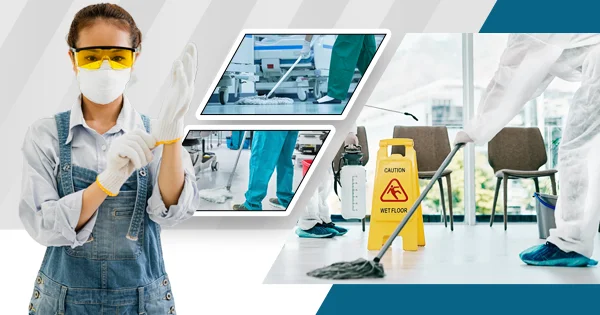Maintaining a clean and hygienic environment is of utmost importance in healthcare facilities. These facilities are responsible for the health and well-being of their patients, and any lapse in cleanliness can lead to the spread of infections and diseases. Deep cleaning plays a crucial role in preventing the transmission of harmful germs and bacteria, ensuring the safety of both patients and staff. Regular cleaning, while important, may not be sufficient to eliminate hidden dirt, germs, and bacteria that can accumulate in hard-to-reach areas. Deep cleaning goes beyond the surface level and targets these hidden contaminants, providing a thorough and effective cleaning solution. By implementing a comprehensive deep cleaning plan, healthcare facilities can create a safe and healthy environment for everyone.
Understanding the Difference Between Regular Cleaning and Deep Cleaning
Regular cleaning involves routine tasks such as sweeping, mopping, and dusting. While these tasks are essential for maintaining cleanliness, they may not be enough to eliminate all germs and bacteria. Regular cleaning often focuses on visible surfaces, neglecting hard-to-reach areas where dirt and pathogens can accumulate.
Deep cleaning, on the other hand, involves a more thorough and intensive approach. It targets hidden dirt, germs, and bacteria that regular cleaning may miss. Deep cleaning involves tasks such as disinfecting high-touch areas, steam cleaning carpets and upholstery, sanitising air ducts, and scrubbing floors. By going beyond the surface level, deep cleaning ensures a higher level of cleanliness and reduces the risk of infections.
Create a Comprehensive Deep Cleaning Plan for Your Healthcare Facility
Having a customised deep cleaning plan is crucial for maintaining cleanliness in healthcare facilities. Each facility has its own unique needs and challenges, so a one-size-fits-all approach may not be effective. A deep cleaning plan should take into account factors such as the size of the facility, the number of patients, and the specific areas that require attention.
The key components of a deep cleaning plan include frequency, scope, and checklist. The frequency of deep cleaning should be determined based on the needs of the facility. High-traffic areas and high-touch surfaces may require more frequent deep cleaning compared to less frequently used areas. The scope of deep cleaning should cover all areas of the facility, including patient rooms, waiting areas, restrooms, and common areas. A checklist should be created to ensure that all tasks are completed during each deep cleaning session.
Identifying High-Touch Areas and How to Clean Them Effectively
High-touch areas are areas that come into contact with multiple people and are more likely to harbour germs and bacteria. In healthcare facilities, common high-touch areas include doorknobs, light switches, patient beds, handrails, and elevator buttons. These areas require special attention during deep cleaning to prevent cross-contamination.
To clean high-touch areas effectively, it is important to use the proper techniques and products. Surfaces should be cleaned first with a detergent or soap to remove dirt and grime. Afterwards, a disinfectant should be applied to kill any remaining germs and bacteria. It is important to follow the instructions on the disinfectant label for proper use and contact time. Microfiber cloths are recommended for cleaning high-touch surfaces as they are effective at trapping dirt and bacteria.
Choosing the Right Cleaning Products and Equipment for Deep Cleaning
Choosing the right cleaning products and equipment is essential for achieving optimal results during deep cleaning. It is important to use EPA-approved disinfectants and cleaning agents that are effective against a wide range of pathogens. These products should be used according to their instructions for maximum effectiveness.
In addition to disinfectants, various types of cleaning equipment can aid in deep cleaning. Microfiber cloths are highly effective at trapping dirt and bacteria without spreading them around. Steam cleaners can be used to sanitise carpets, upholstery, and other surfaces. UV-C lights can be used to kill germs and bacteria on surfaces and in the air. It is important to choose equipment that is suitable for the specific needs of the facility and to ensure that it is properly maintained.
Training Your Staff on Proper Deep Cleaning Techniques and Procedures
Providing comprehensive training to your cleaning staff is crucial for ensuring that deep cleaning is done correctly and effectively. Training should cover various aspects of deep cleaning, including safety, infection control, and quality assurance.
Safety training should include proper handling of cleaning chemicals, the use of personal protective equipment (PPE), and the prevention of slips, trips, and falls. Infection control training should cover proper hand hygiene, the use of disinfectants, and the prevention of cross-contamination. Quality assurance training should focus on the importance of following cleaning protocols, completing tasks thoroughly, and reporting any issues or concerns.
Implementing Quality Control Measures to Ensure Consistency in Deep Cleaning
Monitoring and evaluating the effectiveness of your deep cleaning program is essential for maintaining a high level of cleanliness in healthcare facilities. Implementing quality control measures can help ensure consistency and identify areas for improvement.
Inspections should be conducted regularly to assess the cleanliness of different areas in the facility. Audits can be performed to evaluate the performance of cleaning staff and identify any training needs. Feedback mechanisms, such as surveys or suggestion boxes, can be used to gather input from patients and staff regarding the cleanliness of the facility. By implementing these quality control measures, healthcare facilities can continuously improve their deep cleaning program.
Dealing with Biohazardous Waste and Infection Control During Deep Cleaning
Deep cleaning in healthcare facilities often involves handling biohazardous waste such as sharps, needles, and bodily fluids. It is important to follow proper protocols for handling and disposing of these materials to prevent the spread of infections.
Biohazardous waste should be placed in designated containers that are leak-proof and puncture-resistant. These containers should be properly labelled and stored in a secure area until they can be disposed of according to local regulations. Cleaning staff should wear appropriate personal protective equipment (PPE) when handling biohazardous waste to protect themselves from potential exposure.
In addition to handling biohazardous waste, infection control protocols should be followed during deep cleaning. This includes wearing PPE, using isolation rooms for patients with infectious diseases, and following proper hand hygiene practices. By adhering to these protocols, healthcare facilities can minimise the risk of infections during deep cleaning.
Maintaining a Safe and Healthy Environment for Patients and Staff
Deep cleaning plays a crucial role in promoting a safe and healthy environment for both patients and staff in healthcare facilities. By removing hidden dirt, germs, and bacteria, deep cleaning reduces the risk of infections and helps prevent the spread of diseases.
However, deep cleaning is not a one-time task. It requires ongoing maintenance and monitoring to sustain a high level of cleanliness and hygiene. Regular inspections, audits, and feedback mechanisms should be implemented to ensure that deep cleaning is being done consistently and effectively. Any issues or concerns should be addressed promptly to maintain a safe and healthy environment for everyone.
The Benefits of Mastering the Art of Deep Cleaning in Healthcare Facilities
Deep cleaning is an essential component of maintaining cleanliness and hygiene in healthcare facilities. By going beyond regular cleaning and targeting hidden dirt, germs, and bacteria, deep cleaning helps prevent the spread of infections and diseases. To master the art of deep cleaning, healthcare facilities should have a comprehensive deep cleaning plan tailored to their specific needs. Staff should be trained on proper deep cleaning techniques and procedures, and quality control measures should be implemented to ensure consistency.
Investing in the right cleaning products and equipment is also crucial for achieving optimal results. By maintaining a safe and healthy environment, healthcare facilities can provide the best possible care for their patients and create a positive working environment for their staff.










